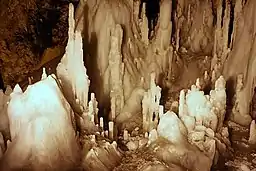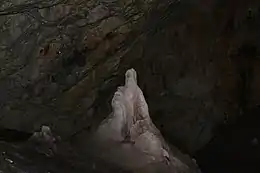Scărișoara Cave
Scărișoara Cave (Romanian: Peștera Scărișoara, Hungarian: Aranyosfői-jégbarlang), is one of the biggest ice caves in the Apuseni Mountains of Romania, in a part of Carpathian chain.[1] It is considered a show cave and one of the natural wonders of Romania. It has also been described as a glacier cave.[2]
| Scărișoara Cave | |
|---|---|
| Scărișoara Glacier | |
 The Church | |
| Location | Gârda de Sus, Alba County, Romania |
| Coordinates | 46°29′23″N 22°48′35″E |
| Depth | 105 m |
| Length | 720 m |
| Elevation | 1,150 m (3,770 ft)[1] |
| Discovery | 1847 |
| Geology | Limestone |
| Entrances | 1 |
| Access | Public |
| Features | Stalactites, stalagmites, columns, parietal hangings, coralites, speleothems |
History
First mentioned in 1863 by the Austrian geographer Arnold Schmidl, who made some observations and the first map of the cave,[3] it was later explored by the Romanian scientist and speleologist Emil Racoviță between 1921 and 1923,[3] who mentioned it and its origin in his 1927 work Speologia (Speleology). The ice cave was formed 3,500 years ago, during the glaciations, when these mountains were covered by snow and ice.[1] The exact date when the cave was first discovered by humans is unknown.[3]
Description

The cave is located at an altitude of approximately 1,150 m (3,770 ft) above sea level.[1] It is 120 m (390 ft) deep and 720 m (2,360 ft) long.[1] The entrance shaft, which is 60 m (200 ft) in diameter and 50 m (160 ft) in depth, gives access through metal stairs to a large chamber, the Great Hall, which is approximately 108 m (354 ft) long and 78 m (256 ft) wide. The Great Hall includes an ice cliff nearly 18 m (59 ft) tall, which overlooks a pool called the Pool of Ice.[1]
From the Great Hall, passages lead into several other named rooms: the Church, which features over 100 ice stalagmites, the Great Reservation, Coman Gallery to the left, and Little Reservation to the right.
The ice within the cave has an estimated volume of 75,000 cubic metres (98,000 cubic yards) and in some places can be as thick as 20 m (66 ft).[1] The temperature is up to +1 °C in the summer and down to -7 °C in the winter. In the part for tourists the average temperature is around 0 °C. Bats live in the ice cave, as do small bugs (2–3 mm long) called Pholeuon prozerpinae glaciale. In the Big Reservation a Rupicapra skeleton was discovered.
Access
The portion of the cave open to tourists includes the entrance shaft, The Big Hall and The Church. Access to the other chambers is reserved for scientific research by the agreement of the Speological Institute of Cluj-Napoca.[1]
References
- Scheffel, Richard L.; Wernet, Susan J., eds. (1980). Natural Wonders of the World. United States of America: Reader's Digest Association, Inc. p. 339. ISBN 0-89577-087-3.
- Scarisoara Ice Cave – the biggest underground glacier in Romania, Travel Guide Romania website, December 24, 2014, retrieved 17 January 2016.
- Steve Kokker, Cathryn Kemp (2004). Romania & Moldova, Lonely Planet Publications, p. 232. ISBN 1-74104-149-X
External links
- Scarisoara Cave - Romanian Monasteries.org